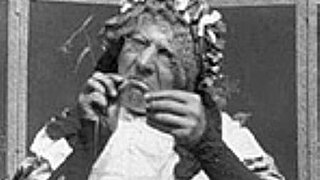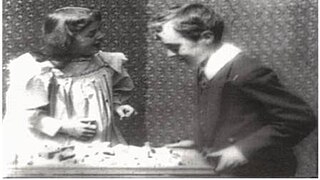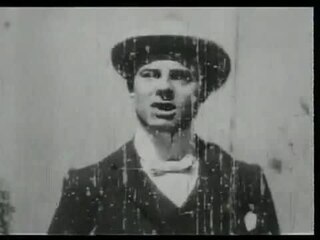
Grandma's Reading Glass is a 1900 British short silent drama film, directed by George Albert Smith, featuring a young Willy who borrows a huge magnifying glass to focus on various objects, which was shot to demonstrate the new technique of close-up. The film, according to Michael Brooke of BFI Screenonline, "was one of the first films to cut between medium shot and point-of-view close-up. It was destroyed in a fire at Warwick Trading Company's studio facility in 1912.

As Seen Through a Telescope is a 1900 British short silent comedy film, directed by George Albert Smith, featuring an elderly gentleman getting a glimpse of a woman's ankle through a telescope. The three-shot comedy, according to Michael Brooke of BFI Screenonline, "uses a similar technique to that which G.A. Smith pioneered in Grandma's Reading Glass (1900)," and although, "the editing is unsophisticated, the film does at least show a very early example of how to make use of point-of-view close-ups in the context of a coherent narrative ." "Smith's experiments with editing," Brooke concludes, "were ahead of most contemporary film-makers, and in retrospect it can clearly be seen that he was laying the foundations of film grammar as we now understand it."

The Kiss in the Tunnel, also known as A Kiss in the Tunnel, is a 1899 film British short silent comedy film, produced and directed by George Albert Smith, showing a couple sharing a brief kiss as their train passes through a tunnel, which is said to mark the beginnings of narrative editing. The film is the first to feature Laura Bayley, Smith's wife.

Grandma Threading her Needle is a 1900 British short silent comedy film, directed by George Albert Smith, featuring a grandma trying to get a thread though a needle. The sole purpose of the single-shot film, like the director's earlier Old Man Drinking a Glass of Beer (1898), according to Michael Brooke of BFI Screenonline, "is to record changing facial expressions for the purposes of entertainment."

The House That Jack Built is a 1900 British short silent drama film, directed by George Albert Smith, featuring a boy who knocks over a house made of bricks built by his sister and then rebuilds it when the original sequence is shown in reverse. "In addition to exploiting a popular cinematic trick," of, "reversing the film in the projector," and, "its audience's presumed knowledge of the technique," the director, according to Michael Brooke of BFI Screenonline, "was continuing his experiments with narrative forms," with the reversed sequence, "interpreted as wish-fulfilment on the part of the girl, hoping that time will literally turn back on itself to allow her house to be rebuilt," he, "demonstrates that while this is impossible in reality, it is easily achievable in cinema."

Explosion of a Motor Car is a 1900 British short black-and-white silent comedy film, directed by Cecil M. Hepworth, featuring an exploding automobile scattering the body parts of its driver and passenger. "One of the most memorable of early British trick films" according to Michael Brooke of BFI Screenonline, "was one of the first films to play with the laws of physics for comic effect." It features one of the earliest known uses in a British film of the stop trick technique discovered by French filmmaker Georges Méliès in 1896, and also includes one of the earliest film uses of comedy delay – later to be widely used as a convention in animated films – where objects take much longer to fall to the ground than they would do in reality. It is included in the BFI DVD Early Cinema: Primitives and Pioneers and a clip is featured in Paul Merton's interactive guide to early British silent comedy How They Laughed on the BFI website.

Tartans of Scottish Clans is a 1906 British short silent documentary film, directed by George Albert Smith as a test for his newly patented Kinemacolor system, which features a sequence of appropriately labelled Scottish tartan cloths, with an abundance of reds and greens, the two colours used by the system. The film, which was one of Smith's first Kinemacolor experiments, was according to Michael Brooke of BFI Screenonline, "a very simple idea which nonetheless demanded colour in order to convey the necessary information."

Woman Draped in Patterned Handkerchiefs is a 1908 British short silent documentary film, directed by George Albert Smith as a showcase of his new Kinemacolor system, which features a woman displaying assorted tartan cloths, both draped on her body and waved semaphore-style. The patterned handkerchiefs are, according to Michael Brooke of BFI Screenonline, "presumably the same cloths featured in Tartans of Scottish Clans (1906), this time shown from various angles."

Spiders on a Web is a 1900 British short silent documentary film, directed by George Albert Smith, featuring a single shot close-up of two spiders trapped in an enclosure. The film is, according to Michael Brooke of BFI Screenonline, "less formally ambitious," than the director's, "groundbreaking multiple close-up study Grandma's Reading Glass (1900), made the same year, but is nonetheless, "one of the earliest British examples of close-up natural history photography, predating Percy Smith's insect studies by a decade."

Santa Claus is an 1898 British short silent drama film, directed by George Albert Smith, which features Santa Claus visiting a house on Christmas Eve. The film, according to Michael Brooke of BFI Screenonline, "is believed to be the cinema's earliest known example of parallel action and, when coupled with double-exposure techniques that Smith had already demonstrated in the same year's The Mesmerist (1898) and Photographing a Ghost (1898), the result is one of the most visually and conceptually sophisticated British films made up to then." It has been described as the very first Christmas movie and a technical marvel of its time.

The Old Maid's Valentine is a 1900 British short silent comedy film, directed by George Albert Smith, which features the titular Miss Pimple receiving an unpleasant surprise on 14 February. The film, according to Michael Brooke of BFI Screenonline, "is essentially a facial - a medium close-up shot of a single performer whose changing expression constitutes virtually all the film's dramatic action." David Fisher points out that, "the flapping of the sheet of paper and the movement of the calendar betray the open-air set," which, "makes it difficult to read the message: Just like Mama," whilst, "the remarkably well-behaved cat," which, "sits patently licking its paws," "suggests that Smith may have already learned the trick of smearing the cat's fur with food."

The X-Rays is an 1897 British short silent comedy film, directed by George Albert Smith, featuring a courting couple exposed to X-rays. The trick film, according to Michael Brooke of BFI Screenonline, "contains one of the first British examples of special effects created by means of jump cuts" Smith employs the jump-cut twice; first to transform his courting couple via "X rays," dramatized by means of the actors donning black bodysuits decorated with skeletons and with the woman holding only the metal support work of her umbrella, and then to return them and the umbrella to normal. The couple in question were played by Smith's wife Laura Bayley and Tom Green.

The Big Swallow is a 1901 British short silent comedy film, directed by James Williamson, featuring a man, irritated by the presence of a photographer, who solves his dilemma by swallowing him and his camera whole. The three-shot trick film is, according to Michael Brooke of BFI Screenonline, "one of the most important early British films in that it was one of the first to deliberately exploit the contrast between the eye of the camera and of the audience watching the final film".

Attack on a China Mission is a 1900 British short silent drama film, directed by James Williamson, showing some sailors coming to the rescue of the wife of a missionary killed by Boxers. The four-shot film, according to Michael Brooke of BFI Screenonline, was innovative in content and technique. It incorporated a reverse-angle cut and at least two dozen performers, whereas most dramatic films of the era consisted of single-figure casts and very few shots. Film historian John Barnes claims Attack on a China Mission had "the most fully developed narrative" of any English film up to that time."

Stop Thief! is a 1901 British short silent drama film, directed by James Williamson, showing a tramp getting his comeuppance after stealing some meat from a butcher and his dogs. "One of the first true 'chase' films made not just in Britain but anywhere else", according to Michael Brooke of BFI Screenonline. It was released along with Fire! (1901), "indicating the direction Williamson would take over the next few years, as he refined this new film grammar to tell stories of unprecedented narrative and emotional sophistication."

Let Me Dream Again is a 1900 British short silent drama film, directed by George Albert Smith, featuring a man dreaming about an attractive young woman and then waking up next to his wife. The film stars Smith's real wife, Laura Bayley, as the woman of his fantasies. Bayley would later appear in Smith's 1906 film Mary Jane's Mishap. The film, according to Michael Brooke of BFI Screenonline, "is an excellent example of an early two-shot film, and is particularly interesting for the way it attempts a primitive dissolve by letting the first shot slip out of focus before cutting to the second shot, which starts off out of focus and gradually sharpens." This appears to be the first use of a dissolve transition to signify a movement of a dreaming state to one of reality.

Undressing Extraordinary is a 1901 British short silent comedy film, directed by Walter R. Booth, featuring a tired traveller struggling to undress for bed. The film, "provides one of the earliest filmed examples of something that would become a staple of both visual comedy and Surrealist art: that of inanimate objects refusing to obey natural physical laws, usually to the detriment of the person encountering them," and according to Michael Brooke of BFI Screenonline, "has also been cited as a pioneering horror film," as, "the inability to complete an apparently simple task for reasons beyond one's control is one of the basic ingredients of a nightmare."

The Biter Bit is an 1899 British short black-and-white silent comedy film, produced by Bamforth & Co Ltd, featuring a boy playing a practical joke on a gardener by grasping his hose to stop the water flow and then letting go again when the gardener looks down it to check. The film, "is an English remake" of Auguste and Louis Lumière's L'Arroseur Arrosé (1895), according to Michael Brooke of BFI Screenonline, "providing a good illustration of how early film production companies cheerfully plagiarised each other's work" with "a few minor differences between, most notably a rather greater sense of space and depth in the Bamforth version" and "three distinct planes to the action". It is included in the BFI DVD Early Cinema: Primitives and Pioneers and a clip is used in Paul Merton's interactive guide to early British silent comedy How They Laughed on the BFI website.

Willie's Magic Wand is a 1907 British short silent comedy film, directed by Walter R. Booth, featuring a young boy terrorising the household with his father's magic wand. Similar to "earlier trick films The Haunted Curiosity Shop and Undressing Extraordinary ," this is, according to Michael Brooke of BFI Screenonline, "essentially a series of [loosely linked] special-effects set pieces," however, "the print in the National Film and Television Archive is incomplete, omitting amongst other things a come-uppance where Willie is punished for his misdemeanours by being turned into a girl, thus depriving him of more than one magic wand." A clip from the film is featured in Paul Merton's interactive guide to early British silent comedy How They Laughed on the BFI website.

Army Life; or, How Soldiers Are Made: Mounted Infantry is a 1900 British short black-and-white silent propaganda actuality film, directed by Robert W. Paul, featuring the King's Own Royal Lancaster Regiment riding over a plain. The film, which premiered on 18 September 1900 at the Alhambra Theatre in London, England, "is all that appears to remain of one of R.W. Paul's most ambitious projects," which, according to Micahael Brooke of BFI Screenonline, "had it survived in a more complete form," "would undoubtedly be considered one of the most important precursors of the modern documentary."




















